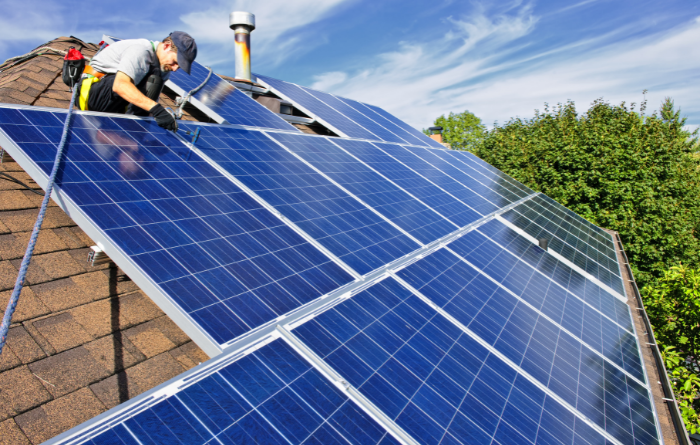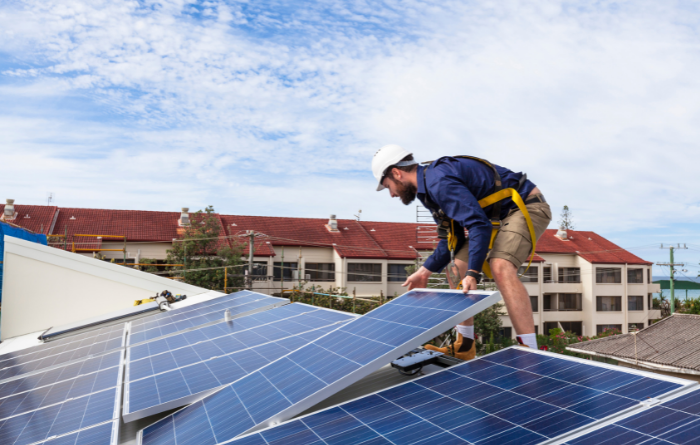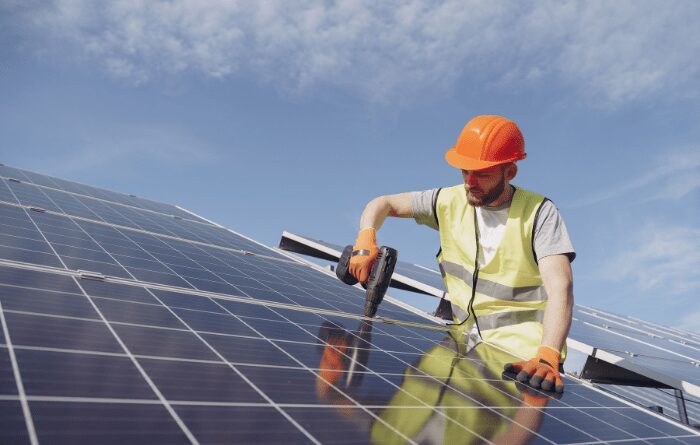Solar panels are becoming an increasingly popular way to generate electricity in the UK. They are a renewable source of energy that can help you save money on your electric bill. With average household energy bills capped at £2,500 a year only until March 2023, and expected to increase further after this, household budget are going to come under increasing pressure. The installation of solar panels offers a long-term solution to the high cost of energy bills and in some instances could save a household as much as £500 annually (according to the Energy Saving Trust and based on October 2022 prices).
But how are solar panels installed? And what do you need to consider before making the switch to solar power?
In this article, we will walk you through the step-by-step installation process and explain how you could be eligible for a solar panel grant to help offset the initial cost.
The Installation Process
Solar panel installation is very simple. The process typically takes one to two days and can be done by a qualified solar installer.
Here are the steps involved in a typical installation:
1. Scaffolding is set up around the property
This is to provide a safe working platform for the solar installer.
2. The solar power mounts are installed
These mounts will hold the solar panels in place. They are typically made of aluminium or steel and are attached to the roof or ground with bolts. It is important that they are set at an angle of between 15 and 45 degrees to maximise the amount of sunlight that hits the solar panels.
3. The solar panels are installed on the mounting structure
The solar panels themselves are then attached to the mounts using brackets. It is important that the installer makes sure that the panels are level and that they are not damaged in any way. Once the solar panels are in place, the installer will then connect them together using cables.
4. The solar panels are wired
The solar panels are then wired together in series with MC4 connectors used to connect the solar panels to each other.
5. The inverter is installed
The inverter is a key component of the solar panel system as it converts the DC electricity from the solar panels into AC electricity, which can be used to power your home. The inverter is usually mounted on a wall or on the floor. The placement of the inverter will depend on the size and type of system you have installed but you should try to keep it out of direct sunlight.
6. The battery is connected to the inverter
If you have a battery-backed system, the batteries will need to be connected to the inverter. The battery will enable you to store excess electricity generated by the solar panels and use it at night or during a power outage.
7. The inverter is connected to the consumer unit
The next step is to connect the inverter to the consumer unit, which is where your home’s electrical supply comes from. This will enable you to use the electricity generated by the solar panels to power your home.
8. The solar panels are tested
Finally, once the system has been installed, the solar installer will test the system to ensure that it is working correctly.

How to Choose a UK Solar Panel Installer
When choosing a solar panel installer, it is important to select a qualified and experienced professional. All installers must be MCS certified in order to install solar panels and for you to receive the government’s Smart Export Guarantee payments. MCS stands for Microgeneration Certification Scheme and is a UK-wide quality assurance scheme.
You can find qualified solar panel installers through the Renewable Energy Consumer Code (RECC) website. All RECC members must adhere to a code of practice which includes providing you with accurate information, carrying out installation work to a high standard, and ensuring that you are happy with the work before they leave your property.
You can also check whether an installer is accredited by the Solar Trade Association (STA). The STA is the UK’s leading solar trade body and all of its members must meet its high standards.
Maintenance Considerations
Solar panels require very little maintenance. Once they are installed, they should last for 25 years or more. You will need to keep an eye on the condition of your solar panel system and make sure that there is nothing blocking the panels, such as leaves or snow. You should also check the inverter regularly to ensure that it is working correctly.
How Much do Solar Panels Cost?
Solar panel systems usually range in cost from around £4000 to £8000, depending on the size and type of system. In addition to these costs, you will also need to consider the cost of installation and whether you want to add an additional battery to your system. All of this means that the total cost of your solar panel system could end up costing you in excess of £10,000.
What Financial Assistance is Available?
The UK government recognises that these costs mean solar panels are beyond the budget of many households. This is why they have introduced various grants to help people purchase and install renewable energy technologies like solar power systems.
If you are thinking of installing solar panels, you may be eligible for the government’s Energy Company Obligation (ECO) scheme. This scheme is designed to help low-income households reduce their energy bills by providing funding for energy efficiency measures.
Who is Eligible for the ECO Scheme?
In order to qualify for the ECO4 scheme, you must fulfil certain criteria such as:
- Being in receipt of certain benefits such as Pension Credit, Jobseeker’s Allowance, or Working Tax Credit.
- Living in a property with an EPC rating of band C or below.
- Having a household income below a certain threshold (this amount varies depending on the number of children you have and whether you are a single or two-parent household)
If you meet the criteria for the ECO scheme, you could receive up to £10,000 towards the cost of purchasing and installing solar panels. To find out more about the help available to you, enter your postcode here.

How does the ECO4 Application Process Work?
If you think you might be eligible for the ECO scheme, you will need to contact an accredited installer who will carry out a free assessment of your property. As explained above, this means an installer who is registered with the Microgeneration Certification Scheme (MCS).
The installer will then provide you with a quote for the work. If you are happy to proceed, they will submit an application to your chosen energy supplier on your behalf. Once the application has been approved, the installer will arrange a date to carry out the work. The whole process will usually take around six weeks.
What are the Benefits of Solar Panels?
Solar panels offer many benefits, both to your household and to the environment. The main benefit of solar panels is that they generate renewable energy which means you won’t be using fossil fuels for your energy. Solar panels also require very little maintenance and once they are installed, they should last for 25 years or more.
Solar panels can also save you money on your energy bills. The amount of money you save will depend on the size of your solar panel system and how much electricity you use, but the average household could expect savings of anything from around £200-£500 a year (varying according to how much they are home throughout the day). With UK energy bills at an all-time high, these are significant savings.
Solar panels are also eligible for the government’s Smart Export Guarantee scheme. This scheme allows households with solar panels and wind turbines to be paid for the excess electricity they generate. The amount you are paid will depend on how much electricity you sell back to the grid but it is a great way to earn some extra money and offset the cost of your solar panel system.
Solar panels also increase the value of your property. In fact, one study conducted by the real estate company Zillow found that having solar panels increased property value by an average of 4.1%.

Final Thoughts
We hope this guide to how solar panels are installed has been useful in helping you understand the process. Solar panel installation is relatively straightforward and with the cost of solar panels falling and potential financial assistance available through ECO4, now is a great time to invest in this renewable energy technology.
To find out whether your property is eligible for the ECO scheme, enter your postcode here.
